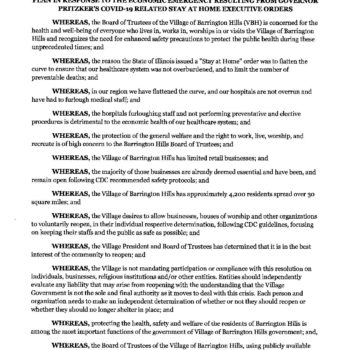Village Hall Closed in Observance of Memorial Day
- Posted by Barrington Hills
- On May 22, 2020
Monday, May 25th is Memorial Day, a day honoring the men and women who died while serving in the US military. It originated after the Civil War as Decoration Day and officially became “Memorial Day”, a federal holiday, in 1971. We are truly grateful to those who gave the ultimate sacrifice.
Village Hall is closed in observance of this federal holiday. For emergencies, dial 911. For non-emergencies, dial QuadCom Police Dispatch at 847-428- 8784.
Every year, the Village of Barrington Hills places a wreath next to the civil war commemorative plaque located on the grounds of the New Friends Wesleyan Church in Barrington Hills, which back in the 1860s, was known as Miller Grove in Barrington Township–not Barrington Hills. Below is its history as documented by former Village Administrator Robert Kosin:
Barrington Center Miller Grove 1862
In the spring of 1862, on these grounds, 90 people from the first generation of settlers pledged an oath of fidelity to the Union — one was a woman who joined as a nurse. Mustered to battles far afield the group, with their lives and fortunes in peril, engaged in armed defense of the principal foundation of a young nation: that all men are created equal, that they are endowed by their Creator with certain unalienable Rights that among these are Life, Liberty and the Pursuit of Happiness. Those who returned from the Civil War resumed their civic labor in governance and tillage to build an enduring legacy still seen in the beauty of the land and the continued resolve of its protectorate.
* * *
It’s not hard to imagine the landscape of 1860 when standing today at the northeast corner of Old Sutton and Dundee Road in Barrington Hills, Illinois. A canopy of trees covers the roadways. No sidewalks, curbs or fire hydrants can be seen. But for the overhead utility lines, little evidence exists that there has passed one hundred and sixty years since the corner was known as Miller Grove in Barrington Township.
According to the federal census taken in the spring of that year, 607 persons lived in that township alone, with thriving enclaves along the Fox River to the west. Most notably was Dundee and Carpentersville with their dairies, Coopers and Millers, all the commercial activity needed by the farming residents of the Grove. There, general news of the day was exchanged with the travelers between the River towns or from Chicago who traversed nothing more than a foot path to their destination. By the Fall, in the general election, the township residents in a majority voted for Abraham Lincoln as their president and change came.
The Township headquarters, most basic unit of government, was located in Miller Grove and through it occurred the communication of the federal government to the states. With the declaration of war in 1861, an initial request (of the governor) was made by the Secretary of War for volunteers to serve in the Union army. The Battle of Bull Run that year revealed that service was not going to be limited to a few months by a patriotic few but rather years and by tens of thousands. In July of 1862, each township was given a quota of men between the ages of 18 and 45 to enlist in the army. Later that Summer, eighty-nine men enlisted at Miller Grove.
The adjutant general muster record in the possession of the Secretary of State of Illinois contains their service. Those from Miller Grove fought in infantry, cavalry, and artillery units in most of the horrific battles of the war. Among them was a woman, who served with her husband and brothers as a nurse–the first war that saw such ministration. Other than the official record in the state archives, for those that returned no recitation or commemoration exists of their service but one.
On May 25, 1933 some seventy years after enlistment, a plaque was affixed to a boulder containing the names of all the inductees in the Civil War from Miller Grove, the nearby farms and with the names of her brothers and husband, the nurse. Assembled through the efforts of the American Foreign Legion, some 800 persons gathered to unveil the plaque in the traditional service of what has become known as Memorial Day. When such commemoration was known as Decoration Day, a parade of veterans organized as the Grand Army of the Republic passed before the adoration of a grateful populous, but on that day in May, only two veterans still survived to witness the installation of the permanent honor roll. The guest speaker Judge Charles S. Cutting said,
“I am not one of that kind of pacifist who believes that services of this type in honor of our solider heroes breed war. Every country has its heroes, both civil and military. It is fitting that we pay respect to them. This old church where the men enlisted will not endure much longer but the monument which you people have erected to the memory of the Civil War veterans will remain here indefinitely. Throughout the years when people come along this highway and stop to look at the boulder and plaque, they will say, ‘Here is a monument to patriotism.’”
Decades later the ninety names are still legible, but Miller Grove is gone. The Township headquarters moved when the Northwestern Railroad came through and gave rise to the town of Barrington. Some of the veterans moved into Barrington and continued in service to that new town. Sons and acquaintances of the honorees were still living when their land was incorporated into the Village of Barrington Hills. Dairy farms were replaced with planned estates and equestrian farms. Some farms were acquired by forest preserves and the woodlands became valued for their landscape rather than a commodity. Their names remain affixed to local roads that still contact those River towns from points still rural in appearance. Judge Cutting was right; the boulder is to patriotism as history has shown, to home and country and generations that came after them.




